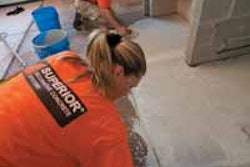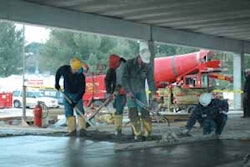Believe it or not, this month's column is not about your spouse restricting your play time, or about how much time you put in on the job, but about insurance. Many of you think today's insurance markets have you held captive - which is probably close to the truth. But we're here to see if we can make you a more profitable "captive" by changing your insurance equation around.
The amount you spend on insurance is probably the second biggest expense you incur, other than payroll. Over the past 10 years, it seems dealing with insurance matters takes more and more time, not to mention dollars, with no relief in sight. The cost bounces all over the place, you can't get an answer about what's happening in your markets, carriers are jumping ship. When you add it all up (health, workman's comp and property and casualty), it is completely out of hand.
To make matters worse (if that's possible), consider how much insurance companies just "love" to deal with construction firms. Let's face it, they don't. Your business is complicated and susceptible to large claims. It's no cup of tea for an underwriter, resulting in unstable and expensive insurance markets for contractors.
When you get down to it, however, insurance is a pretty simple business if you can control your risk. The underwriter takes your money based on his assessment of your potential losses, then makes adjustments as actual losses take place. Show the underwriter you have the ability to beat the odds and he will charge you less. Cost him money and you pay more. Pretty simple - all you have to do is control your business.
But as we all know, the contracting business is one of the toughest to control. And when you combine poor performers with the "best in class", the rates paid by the better performers are higher than they should be.
To counteract current insurance forces, business owners are taking steps to get control of insurance costs by forming "captives". You have all heard the term, along with the positive and negative stories that go with it. Yet, set up and controlled properly, they do work and offer not only lower insurance costs but tax advantages, as well. The savings can be upward to 25% of current quotes, which is nothing to sneeze at in today's insurance market.
What is a captive?
Since I know just enough about captives to be dangerous, I asked Bob Andersen, Andersen Insurance Consulting, (312) 663-9252 or [email protected], to help me with this column. Bob has extensive experience with captives (over 15 years) and has an excellent knowledge of the insurance markets.
My first question to Bob was "what is a captive?" He provided this explanation: "A captive is an insurance company designed to provide insurance for the specific needs of the owners (those accepted into the group). A variety of solutions are available, depending on the data obtained and long-term objectives of the group. This company buys for a target group and not the entire industry. Specific acceptance guidelines and goals govern the captive."
A captive is created to stabilize or reduce insurance cost; establish an above-average claim experience; recapture investment income; support risk management; provide access to innovative deals; warehouse data; and produce a profit.
"Captives only admit acceptable players with both good risk profiles and proper claim controls, allowing the group to present a ‘best in class' claim history to underwriters resulting in lower premiums," Bob continued. "In addition, because of lower overhead costs, and control over claims and claim settlements, the total cost of the ‘insurance' should be within or less then the underwriters' original estimate."
Bob also pointed out that captives offer tax advantages since they are normally established offshore.
How is it set up?
My second question was "how do you set up a captive for a group of contractors?"
According to Bob, over the past five years, the alternative insurance market has expanded to offer multiple choices, including captives, risk retention groups, rent/a/captive, etc. Each program has risk/reward considerations, depending on where each business owner is in their personal business development.
"Groups of the ‘best of class' have to find one another to analyze their ability to enter such a program," he stated. "Done right, the rewards can be outstanding. Done poorly, with loose acceptance standards, leads to the horror stories you have all heard. The opportunities are there, however, if the group is willing to invest some time and dollars. Consultants like Bob Andersen can help contractors form such groups."
He added, "To work best, captives need at least $5 million in annual premiums."
Bob cautioned against letting "average" performers participate in a captive. "To safeguard the longevity of this program, entrance standards must be maintained," he stressed. "The higher the standard, the better off members are because owners understand the business better than insurance companies do. In short, members know how to set up and monitor loss controls."
That's a brief summary of the opportunities related to captives. Those of you with the means to know your peers across the region and/or country may find captives attractive, or at least worth looking at. Again, properly established and managed, they can work remarkably well with little reason for members to bail because of changes in the insurance market.
Whoever thought being "captive" could set you free - or at least set your cash flow free? Fortunately, it can.
Garry Bartecki is director of dealer/distributor services at BDO Seidman, LLP of Chicago, as well as a consultant to the AED. He has also worked as an independent CPA and consultant to equipment dealers. He can be reached at (312) 616-4677 or [email protected].
Reduced Costs Plus Profits
Contractors who are financially sound, manage and run good solid companies, and maintain a good safety record can benefit and even profit from insurance costs through a captive insurance company.
Insurance typically works on a 60/40 ratio - for every dollar spent on insurance, approximately $.60 is earmarked toward potential losses, while $.40 goes to the insurer's fixed costs. In traditional arrangements, a piece of business with a 60% loss ratio or less can be profitable for the insurance carrier. In a captive, any unused portion of the 60% dedicated for potential losses will be used to accrue investment income, and ultimately will be attributed back to the captive owner as underwriting profit and investment income.
Progressive Contractors, Inc., a Minnesota-based highway contractor, is benefiting from these investment returns. Progressive is partnered with 12 other contractors in a construction-centered captive insurance company.
"We now understand that it is not what we pay up front that matters, it is the amount of losses we pay out that determines our success," says Mike McGray, president of Progressive Contractors. "A captive solution gives us a way to stabilize the cost of insurance and to see financial benefits through underwriting savings and investment income."
Captives vary in size from a single contractor to 50 or more working together. The initial capital investment required from each owner is determined by the captive structure and the requirements of the chosen captive domicile.
"To qualify for our captive, partnering companies had to show solid financial performance and good loss histories," notes Mark Knight, vice president of Foothills Contracting, Inc., a third-generation, heavy highway construction firm operating throughout the upper Midwest.
Foothills Contracting is benefiting from the captive by becoming a more safety-conscious company. "With traditional insurance, workers' compensation was one of our largest and most expensive lines of insurance. Although it's a regulated cost, the enhanced loss control program we now have in place because of our captive company enables us to control that cost, too," he explains.
The opportunity for networking with other owners on best practices is another advantage. "The partner companies in our captive come from diverse industries, but we have important things in common, " says Stan Lanford, Jr., chairman of the board of Lanford Brothers Co., Inc., a general contractor that works with state DOTs in Virginia, North Carolina, and South Carolina. "We are all second- or third-generation family-owned companies with strong balance sheets and corporate cultures that emphasize safety from the top down. We learn from each other."
Source: Daniel T. Keough, founder, Innovative Captive Strategies, Inc., a captive consultant that facilitates incorporation/management of captive insurance companies.



















